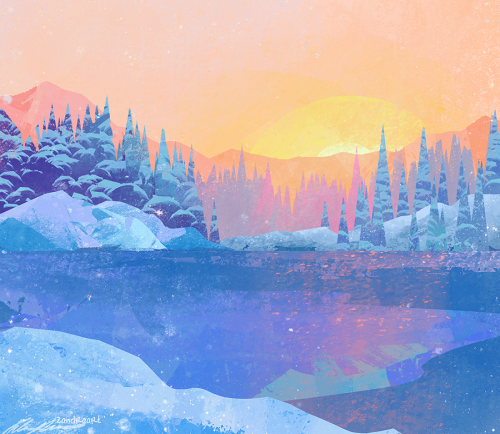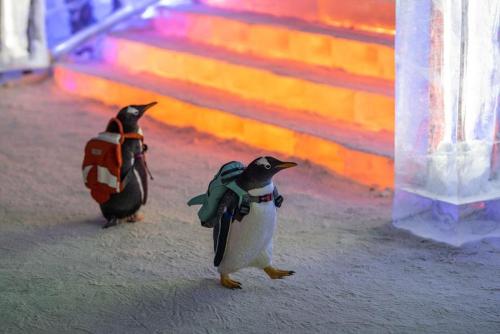The Colors Of Winter

the colors of winter
More Posts from Eggxecutive-dysfunction and Others

The Colorful Clouds of Rho Ophiuchi : The many spectacular colors of the Rho Ophiuchi (oh’-fee-yu-kee) clouds highlight the many processes that occur there. The blue regions shine primarily by reflected light. Blue light from the Rho Ophiuchi star system and nearby stars reflects more efficiently off this portion of the nebula than red light. The Earth’s daytime sky appears blue for the same reason. The red and yellow regions shine primarily because of emission from the nebula’s atomic and molecular gas. Light from nearby blue stars - more energetic than the bright star Antares - knocks electrons away from the gas, which then shines when the electrons recombine with the gas. The dark brown regions are caused by dust grains - born in young stellar atmospheres - which effectively block light emitted behind them. The Rho Ophiuchi star clouds, well in front of the globular cluster M4 visible here on the upper right, are even more colorful than humans can see - the clouds emits light in every wavelength band from the radio to the gamma-ray. via NASA

Recycling Cassiopeia A : Massive stars in our Milky Way Galaxy live spectacular lives. Collapsing from vast cosmic clouds, their nuclear furnaces ignite and create heavy elements in their cores. After a few million years, the enriched material is blasted back into interstellar space where star formation can begin anew. The expanding debris cloud known as Cassiopeia A is an example of this final phase of the stellar life cycle. Light from the explosion which created this supernova remnant would have been first seen in planet Earth’s sky about 350 years ago, although it took that light about 11,000 years to reach us. This false-color image, composed of X-ray and optical image data from the Chandra X-ray Observatory and Hubble Space Telescope, shows the still hot filaments and knots in the remnant. It spans about 30 light-years at the estimated distance of Cassiopeia A. High-energy X-ray emission from specific elements has been color coded, silicon in red, sulfur in yellow, calcium in green and iron in purple, to help astronomers explore the recycling of our galaxy’s star stuff. Still expanding, the outer blast wave is seen in blue hues. The bright speck near the center is a neutron star, the incredibly dense, collapsed remains of the massive stellar core. via NASA

Penguins attend classes on the first day of school at the University of Antarctica, 2007
the ham is melting, the turkey is suspended in midair, the salami is hatching from its own egg. why did we even come to the salvador deli

Sabiá-laranjeira/Rufous-bellied Thrush
Turdus rufiventris

Eurasian nuthatch/nötväcka.










These are days 1 through 4 of my Falsetober so far this year! Formats a bit weird for horizontal images, but whatever!

king of birds
-
 thenightking4000 reblogged this · 2 weeks ago
thenightking4000 reblogged this · 2 weeks ago -
 thenightking4000 liked this · 2 weeks ago
thenightking4000 liked this · 2 weeks ago -
 the-pirate-captain liked this · 1 month ago
the-pirate-captain liked this · 1 month ago -
 zebrasonice-reblogs reblogged this · 2 months ago
zebrasonice-reblogs reblogged this · 2 months ago -
 winter-schnee reblogged this · 3 months ago
winter-schnee reblogged this · 3 months ago -
 ajz0626 reblogged this · 3 months ago
ajz0626 reblogged this · 3 months ago -
 ajz0626 liked this · 3 months ago
ajz0626 liked this · 3 months ago -
 littlevnavy liked this · 3 months ago
littlevnavy liked this · 3 months ago -
 littlevnavy reblogged this · 3 months ago
littlevnavy reblogged this · 3 months ago -
 little-ms-innocent liked this · 3 months ago
little-ms-innocent liked this · 3 months ago -
 scruffypegasus liked this · 3 months ago
scruffypegasus liked this · 3 months ago -
 temporalfool reblogged this · 3 months ago
temporalfool reblogged this · 3 months ago -
 temporalfool liked this · 3 months ago
temporalfool liked this · 3 months ago -
 ririe-likes-stuff liked this · 3 months ago
ririe-likes-stuff liked this · 3 months ago -
 sleepyskittykat reblogged this · 3 months ago
sleepyskittykat reblogged this · 3 months ago -
 sleepyskittykat liked this · 3 months ago
sleepyskittykat liked this · 3 months ago -
 oneheadedcerberus reblogged this · 3 months ago
oneheadedcerberus reblogged this · 3 months ago -
 moonflowero1 reblogged this · 3 months ago
moonflowero1 reblogged this · 3 months ago -
 dittolicous reblogged this · 3 months ago
dittolicous reblogged this · 3 months ago -
 hamburgergod liked this · 4 months ago
hamburgergod liked this · 4 months ago -
 sempsstuffandthangs reblogged this · 4 months ago
sempsstuffandthangs reblogged this · 4 months ago -
 her-madjesty reblogged this · 4 months ago
her-madjesty reblogged this · 4 months ago -
 ravensilversea reblogged this · 4 months ago
ravensilversea reblogged this · 4 months ago -
 spaceguylewis reblogged this · 4 months ago
spaceguylewis reblogged this · 4 months ago -
 butterscotcheye reblogged this · 4 months ago
butterscotcheye reblogged this · 4 months ago -
 corniifer reblogged this · 4 months ago
corniifer reblogged this · 4 months ago -
 kintsugaheart reblogged this · 5 months ago
kintsugaheart reblogged this · 5 months ago -
 kdiscontent reblogged this · 5 months ago
kdiscontent reblogged this · 5 months ago -
 hey-kyuu liked this · 5 months ago
hey-kyuu liked this · 5 months ago -
 astrogation reblogged this · 5 months ago
astrogation reblogged this · 5 months ago -
 swimmingpersonmiracle liked this · 5 months ago
swimmingpersonmiracle liked this · 5 months ago -
 puppyberryy liked this · 5 months ago
puppyberryy liked this · 5 months ago -
 dragoncaller reblogged this · 5 months ago
dragoncaller reblogged this · 5 months ago -
 lookingfortranquility reblogged this · 5 months ago
lookingfortranquility reblogged this · 5 months ago -
 myojinoflifesweb reblogged this · 5 months ago
myojinoflifesweb reblogged this · 5 months ago -
 fairylightfairlybright liked this · 5 months ago
fairylightfairlybright liked this · 5 months ago -
 a-collection-of-nonsense reblogged this · 5 months ago
a-collection-of-nonsense reblogged this · 5 months ago -
 azuremidnightspell reblogged this · 5 months ago
azuremidnightspell reblogged this · 5 months ago -
 sundewserpent reblogged this · 5 months ago
sundewserpent reblogged this · 5 months ago -
 thetabbybadger reblogged this · 5 months ago
thetabbybadger reblogged this · 5 months ago -
 iddragonthe3rd reblogged this · 5 months ago
iddragonthe3rd reblogged this · 5 months ago -
 iddragonthe3rd liked this · 5 months ago
iddragonthe3rd liked this · 5 months ago -
 a-tad-unmoored liked this · 5 months ago
a-tad-unmoored liked this · 5 months ago -
 girlfailgaymer liked this · 5 months ago
girlfailgaymer liked this · 5 months ago -
 taylachan liked this · 5 months ago
taylachan liked this · 5 months ago -
 minniestronni reblogged this · 5 months ago
minniestronni reblogged this · 5 months ago -
 minniestronni liked this · 5 months ago
minniestronni liked this · 5 months ago -
 silverseapunk reblogged this · 5 months ago
silverseapunk reblogged this · 5 months ago


